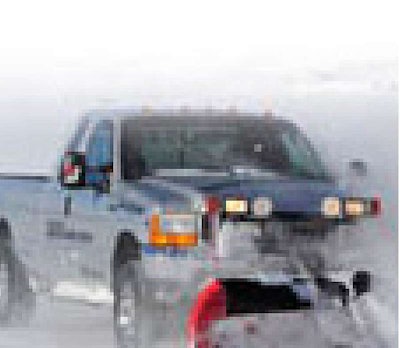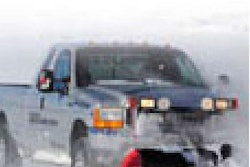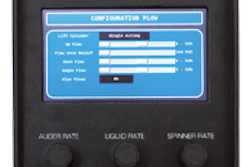Will your trucks be ready?
For fleet managers, it’s time to prep for winter.
While everyone else is having summer fun and worrying about sunblock, savvy fleet managers are getting their trucks, equipment, and parts inventories ready for winters. They know if they don’t, they can get caught out.
 Bridgestone Winter Driving School managers follow their own advice on winter prep, equipping their pickups with dedicated snow tires for plowing miles of roads outside of Colorado Springs, Colo.
Bridgestone Winter Driving School managers follow their own advice on winter prep, equipping their pickups with dedicated snow tires for plowing miles of roads outside of Colorado Springs, Colo.Transitioning between seasons, especially from summer to winter, isn’t an easy task because the working conditions and stresses put on equipment vary so much with the elements. When it comes to setting up a fleet’s pickups and heavy-duty trucks for winter duty, there are some major routine moves to make. But it’s shocking how often some of them get overlooked. And that’s downright dangerous.
I bleed pickups, but here I’m talking everything from half-ton to Class 8 trucks that have to work for you in the dead of winter.
TIRES
No, the “M&S” and “all-season” bargain treads don’t make good winter tires. Neither do mud tires. If winter traction and driver safety are paramount, equip the fleet with dedicated winter tires such as Bridgestone’s Blizzak W965s, Nokian Hakkapeliitta LTs or Goodyear Ultra Grip Ice WRTs. There’s no comparison to the level of vehicle control gained by switching to purpose-built snow/ice tires when winter arrives. To extend their life, switch back to the summer treads when spring arrives.
SNOWPLOWS
All snowplows are not created equal, especially when it comes to those for use on pickups. The newest generations have better moldboard trip mechanisms to keep encounters with curbs and manhole covers from tearing up the plow and the truck and other advances to make old timers shake their heads. To be winter-ready make sure your plow and truck linkages will work in a hurry, that plows and trucks match and that the plow does what you think it will do.
AUTO TRANSMISSIONS
Automatic transmissions take the biggest hit during the winter, especially if the truck is used for plowing. The speeds are low, but the load put on the transmission is high. This means it’s critical to service the transmission, change the external filter, check the fluid to make sure it’s in good condition and inspect the transmisson cooler lines. All it takes to fry an automatic is one overheat scenario.
ENGINE COOLANT
Even though it’s winter, engine temps can be high because snow and ice can block good airflow to the radiator. It’s all the more important that the radiator coolant be in good condition (red/pink color) and water and antifreeze are mixed 50/50. A higher mix percentage of antifreeze hurts cooling.
WINDSHIELD WIPERS
Driver safety begins with a clean windshield, which provides that extra second or two to react. A clean windshield also reduces driver fatigue. Everblades heated wipers are excellent in winter, and the silicone-impregnated versions from Rain-X, PIAA, Tripledge, ArmorAll and SilBlade are good choices. Silicone blades clean better than conventional wipers and they treat the windshield at the same time. Silicone-impregnated wipers also last longer than conventional wipers — especially when subjected to road salts and sand.
SHOCKS
The typical OEM shocks are worn out by the time they have 15,000 miles on them, and the typical high-pressure gas shocks should be replaced with high-pressure gas version after about 40,000 miles. Bad shocks lead to handling issues in the winter— especially when plows and spreaders are installed. So let mileage be your replacement indicator for shocks.
FRONT AXLES
Pay close attention to the boots and tie-rod ends of GM 4x4s; torn CV boots need to be replaced to keep sand and salt from getting into the joints. This is the time to replace the OE outer tie-rod ends of 4×4 diesels with heavy-duty replacements like those offered by Cognito Motorsports. It’s also a good time to check gear oil and replace it if there’s any hint of water in the lube.
WARNING LIGHTS
Safety and visibility go hand in hand. It’s never too late to add a few more high-intensity LED flashers to the truck. A couple of the super mini-LEDs mounted on the headache rack or the front and rear fenders can dramatically improve visibility without a big expense. Whelen and Buyer’s Products are just a few manufacturers that offer the min LEDs.
ENGINE OIL
Winter prep should include switching to “zero-weight” engine oils. These synthetics, such as those from Royal Purple, Mobil Delvac and Pennzoil, provide the lubrication needed when hot, yet keep the engine components protected at cold startup. They can also improve fuel economy.
DISC BRAKES
Stopping power is not only dependent on good tires, it’s how well the brakes work. When water, ice and snow are key elements on the road or jobsite, rotors with slots provide better cleaning and drying performance than smooth OEM versions. Higher quality pads also benefit work pickups. Stainless Steel Brakes Corp (SSBC), Disc Brakes of Australia (DBA) and EBC Brakes have special pickup disc brake upgrade packages with rotors and pads.
HID HEADLIGHTS
Good night vision is dependent on the quality of headlights. Replacing stock OE halogen bulbs with HID Xenons can dramatically improve pickup headlight performance without affecting oncoming traffic (when properly adjusted.) PIAA, Phillips and Oracle Lighting Products offer good kits. Choose an HID kit in the 6,000K range for optimum results.
Editor’s Note: This story was especially written for Better Roads by Bruce Smith, editor of our sister publication ProPickup magazine.












